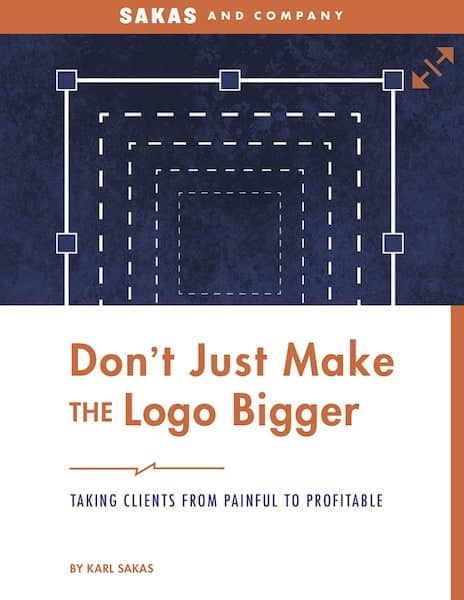A client in the UK recently asked:
“I’ve been experimenting with outsourcing for the past few months and I’ve been unsure what a ‘fair’ profit margin/markup I need to be making. I was wondering if you had any thoughts on this.”
It’s important to mark things up. You need the markup to cover administrative overhead—it’s how your agency stays profitable. So, how much freelancer markup is “normal?”
This is important—the answer will drive both pricing and staffing at your agency. Let’s look at my usual guideline, plus cases when you need to charge more or less than that. [Last updated: April 2024]
Guideline: Pay Freelancers Less Than 1/2 What You Charge Clients
Ideally, you’d take what a freelancer charges and double it, or pay subcontractors up to half of what clients pay you.
If you’re considering a freelancer for a specific project or retainer, it’s an easy decision. If you bill your clients $200/hour, you can pay a freelancer half the billable rate——up to $100/hour.
Or to put it another way, I recommend charging your clients at least 2X what you pay the freelancer. That is, if you pay the freelancer $60/hour, you need to be charging the client at least $120/hour. (But ideally, you’re charging more than that anyway.)
It can be harder to do that 100% markup when subcontractors are doing expensive, in-demand work (for instance, freelance technical SEO experts might charge you $150/hour), or when the firm is under-charging (e.g., $125/hour instead of $200+ for digital marketing services).
You’ll have more flexibility on what you pay freelancers than on what you charge clients—freelancer rates vary widely, but clients aren’t going to be as understanding if a new project costs twice as much because you need to pay a freelancer more.
A key consideration is that freelancers tend to have a higher Billable Ratio than employees—because you’re not paying them for “watercooler” time. I’ll write about employee-related markup (in short: bill them 3X+ their hourly rate) in a future article.
Should You Feel Bad About Your Freelancer Markup?
Some agency owners don’t feel comfortable about marking things up so much, or worry that freelancers will quit if they know you’re marking them up so much.
You’ll need to sort through this. But consider that your agency is providing a valuable service to clients—you find the people, manage the work, and ensure the quality so your agency’s clients don’t have to. Your markup covers that value.
Why pay freelancers just half? You need the markup to cover non-billable expenses at your agency. Since you’re not 100% billable, your markup on freelancers (and employees) is helping to cover your salary.
Labor can also be problematic—it’s a service delivered by fallible humans. If a client doesn’t like the work and chooses to withhold payment when you’ve marked-up a subcontractor by just 10%, now you’re [generally] on the hook to pay the subcontractor anyway, and barely making a profit for the pain. The markup covers this risk.
Naturally, you’ll want a non-solicitation clause in your freelancer contract. You don’t want freelancers pitching the client on hiring them directly—”pay me $90/hour instead of paying the agency $200/hour.”
Applying This to Fixed-Bid Work
Markup is easier on Time & Materials but you can apply it to fixed-bid work, too. Get an estimate from freelancers and mark that up when you quote it to clients.
It’s normal to mark-up non-labor pass-through expenses (like media buys and printing) by 15%, but those tend to be less problem-prone than human labor.
- Printing can be expensive, but it’s one-off. You’re not on the hook constantly. (Also, agencies doing printed work tend have the process down, which means minimal unpaid re-work.)
- Media buys are recurring and can be expensive, but clients are generally happy with the result—if the ads run (and are generally producing sales or other targets), you’re fine.
Add 25-30% for PM Before You Quote the Work
As in Time & Materials, be sure to include your agency’s project management time in your client-facing quote—I recommend that you add 25-30% to the budget. Your team’s PM and client service provides value to the client, so make sure you charge for it. The exact percentage depends the client’s demanding-ness.
When to Pay Freelancers Less Than 1/2
Sometimes you should pay freelancers less than 1/2 (or the flip side, charge clients more than 2x what you pay freelancers). Here are two scenarios for that:
- High P.M. Overhead: If the freelancer requires more project management time, shoot for 1/3 or 1/4. You need a bigger project budget to cover your PM time.
- Low Quality: If the freelancer has to re-do things, you shouldn’t be paying them as much. Highly-skilled freelancers should require fewer re-dos, which makes them more valuable. Long-term, if a freelancer requires lots of re-work, you should replace them with someone else.
Special Expertise: Paying More Than 1/2
You’ll sometimes run into situations when you need to pay a freelancer more than half what you bill the client. This often happens when you need a high-end person to do a particular project.
For instance, I worked at an agency that typically charged $125/hour on a Time & Materials basis. For a particular project, we needed a Microsoft-experienced systems administrator to help us on infrastructure strategy—running Drupal on a Windows server. As it happens, our freelance IT support person had that skillset. But he already was charging us $150/hour.
Our solution was to create a special $200/hour rate for him, which we used when we scoped the project and when we billed the client.
Keys to Making Lower Markup Work
Paying him more than half (3/4 in this case) worked out OK, because we were strategic about it.
- I included this assumption when I built the budget estimate for our project proposal.
- This was a small portion of the total project budget, so it wasn’t a huge impact on margins.
- We needed his high-cost expertise to help us make a new type of project go smoothly, and it helped us avoid making more-expensive mistakes.
Applying This at Your Agency
Remember that my freelancer markup guideline is a guideline, not a strict rule. Sometimes you should pay freelancers more or less than half of what you charge clients.
Cheaper freelancers are more affordable, but they’re often less-billable due to training and “redo it” quality issues. More-experienced freelancers tend to be more expensive, but they tend to be more billable.
Your staffing and compensation decisions are ultimately about value—finding the right balance on value for you and for your clients—while contributing to profits so you have enough money to do things you like doing.
Question: How do you approach freelancer markup at your agency?


